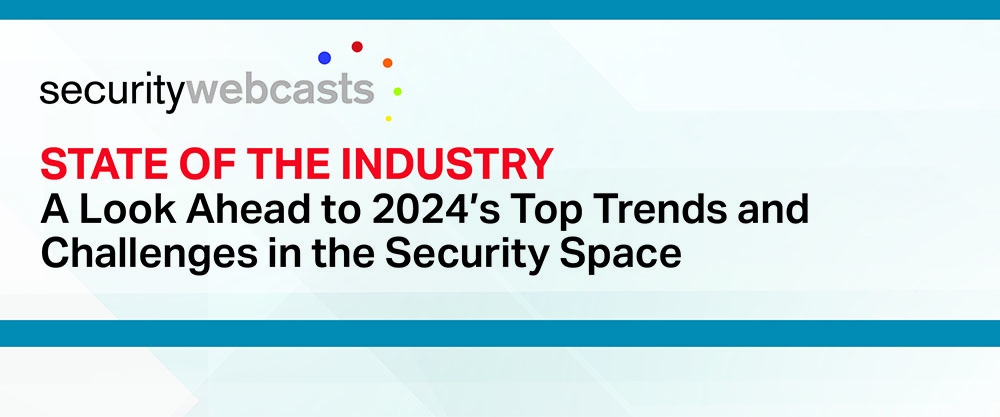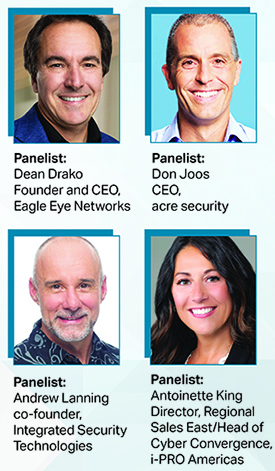SSN webcast sees thought leaders discussing 2024’s top trends and challenges

By Ken Showers, Managing Editor
Updated 1:51 PM CST, Wed January 3, 2024

YARMOUTH, Maine – The evolution of cyber-physical security convergence and the emergence of mobile wallets in the access control space were some of the hot topics addressed during a thought leaders webcast hosted by Security Systems News.
 Titled “State of the Industry - A Look Ahead to 2024's Top Trends and Challenges in the Security Space”, the webcast featured a panel of industry professionals - Antoinette King, director of regional sales for the East and head of cyber convergence for i-PRO Americas; Andrew Lanning, co-founder, Integrated Security Technologies; Dean Drako, CEO of Eagle Eye Networks; and Don Joos, CEO of acre security. The webcast was moderated by Security Systems News Editor Cory Harris.
Titled “State of the Industry - A Look Ahead to 2024's Top Trends and Challenges in the Security Space”, the webcast featured a panel of industry professionals - Antoinette King, director of regional sales for the East and head of cyber convergence for i-PRO Americas; Andrew Lanning, co-founder, Integrated Security Technologies; Dean Drako, CEO of Eagle Eye Networks; and Don Joos, CEO of acre security. The webcast was moderated by Security Systems News Editor Cory Harris.
Cyber-Physical Security Convergence
The panel first began with addressing cyber-physical security convergence, asking how it aligns company’s various security functions against organizational priorities and business objectives.
“It didn’t just happen in the last year, but It’s been happening over a decade now, and we’re just starting to see people recognize the importance of it,” King said, recognizing Lanning’s own long history discussing the topic.
Invoking the imagery of a coin on its side with one half representing physical security and the other cybersecurity, King noted, “When you look at the principles of both they’re identical. The only thing that changes is the assets which we’re protecting. Now as we see more industrial IoT where the technology for physical security is becoming network based, and it has been over the last 10 years, we’re recognizing that because we weren’t securing those endpoint devices that we’re adding more risk too our customer.”
She added that organizations have begun to realize that with third party breaches not only does a company’s network technology need to be secured, but also its operational technology.
Lanning agreed and noted that education on the issue remains a large part of the problem.
“The education piece is still sort of the problem; we don’t like going to our customers and telling them we brought problems into their environment,” he said. “We don’t like to talk about legacy issues. Our industry likes to move forward all the time which is kind of how we ended up with all the cyber risk that we have.”
Access Control Technology
Next, we asked panelists what some of the most active access control technologies in the market currently are and what led to their emergence in the past year.
“I think there’s a couple things I would highlight.” Joos said leading the response. “One is just - as I think from an identity management perspective for end-users and employees of companies, both on their professional and business side - when you think about it from a mobile wallet perspective (whether Apple, or Google, or a Samsung perspective) I think there’s a convenience factor. I think there’s a secure factor in there. I think there’s a blurring of the line between personal and professional, but you want to be able to have your identity and have your authentication so that you have ease-of-use from there. I think we’re going to continue to see more and more of that occurring in the industry. So, identity management is going to be key.”
“The thing that I’ve seen this last year is that the game changer (and it’s been coming) is the Apple wallet, Google, and Samsung basically doing features and capabilities in the phone, so that the phone becomes a good credential,” Drako added. “We’ve been using the phone as a decent credential, even a better credential, but you always had to open up the app, or it had to be running or what not, but now we have a frictionless kind of access. It makes the phone your identifier, you don’t even have to take it out of pocket, or you can wave it at the reader, and you don’t have to open up the app. So, I think that is going to fundamentally change the access control space to move away from all the fobs and the keycards, which are both just fundamentally not secure.”
Drako also noted that monthly and yearly service fees to use said apps will be one of the many things changing the economic impact in the access control space.
“Ease of deployment as well,” added Lanning, “It’s really your identity, you can go anywhere with it and use it for multiple things. We see that in the higher education environments, which is a good example of that, hospitals, and things like that.”
“I think that it all ties into this notion of self-sovereign identity,” King explained. “Where, in a lot of cases, we’re giving some of the identity back to the individual credential holder versus the identity sitting with the system. There’s this very strong push, and conversation that’s out there about identity, and biometrics, and how the identity of the person stays with the person in the individual systems that could be more secure.”
The full webcast can be accessed by visiting www.securitysystemsnews.com/webcasts and following the link.
Comments